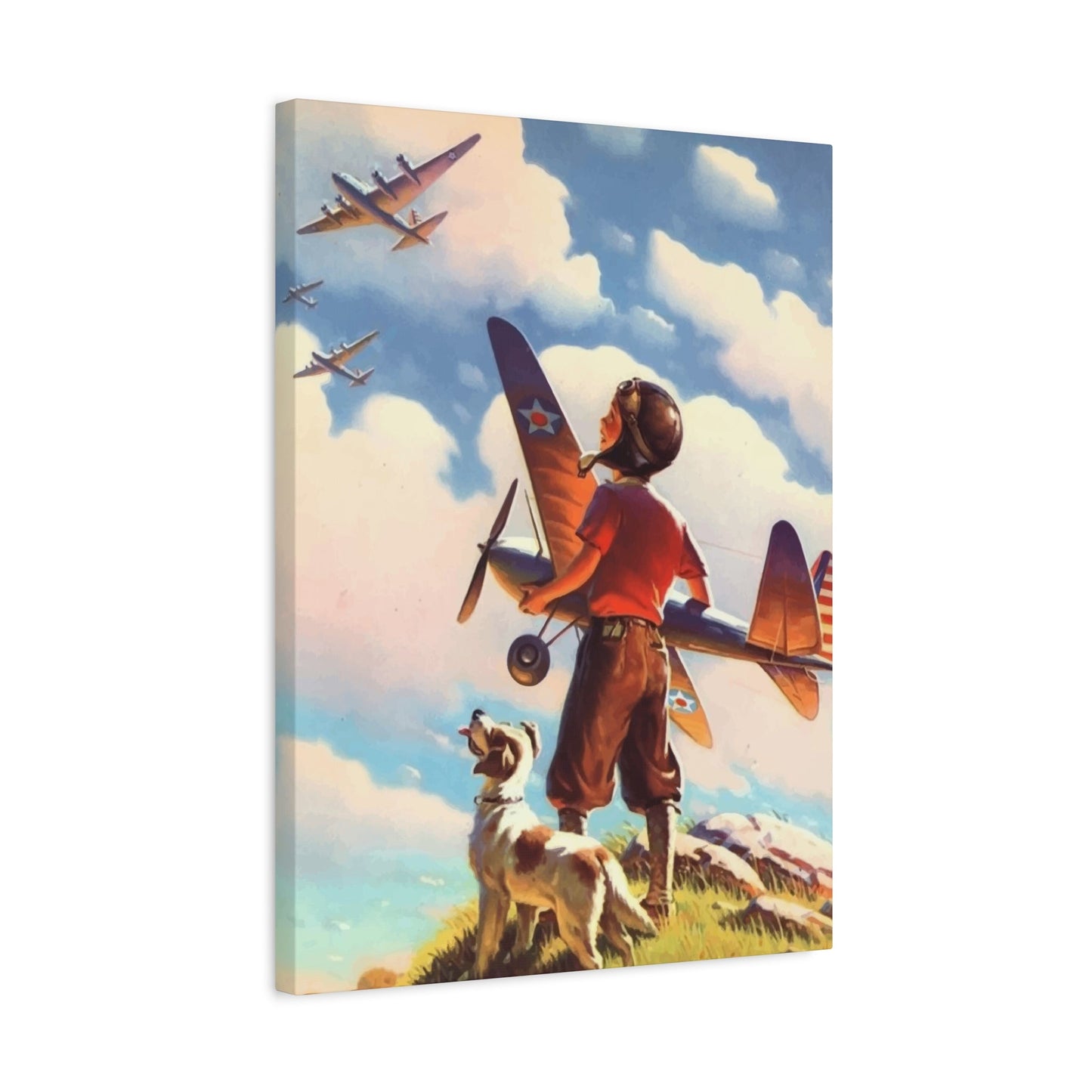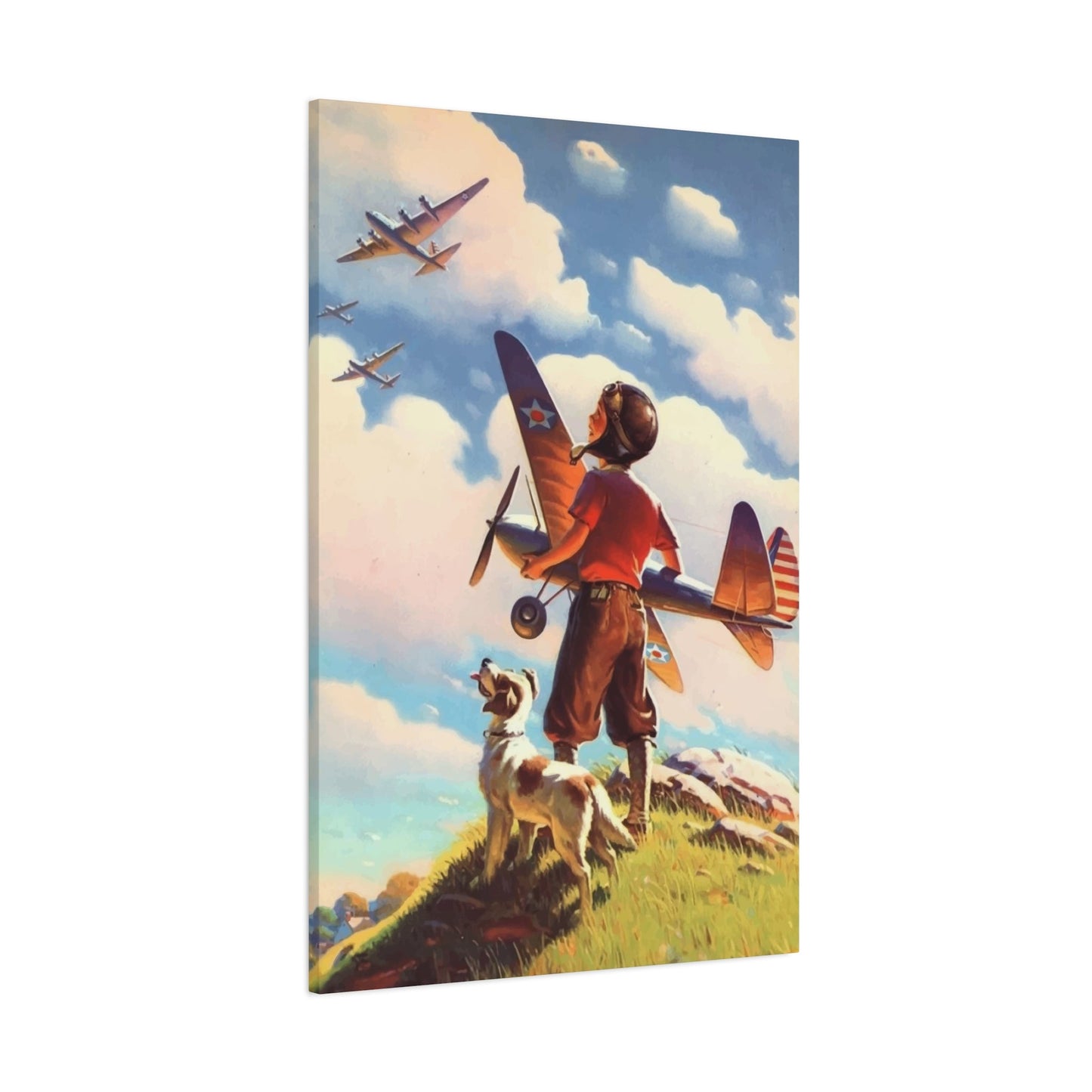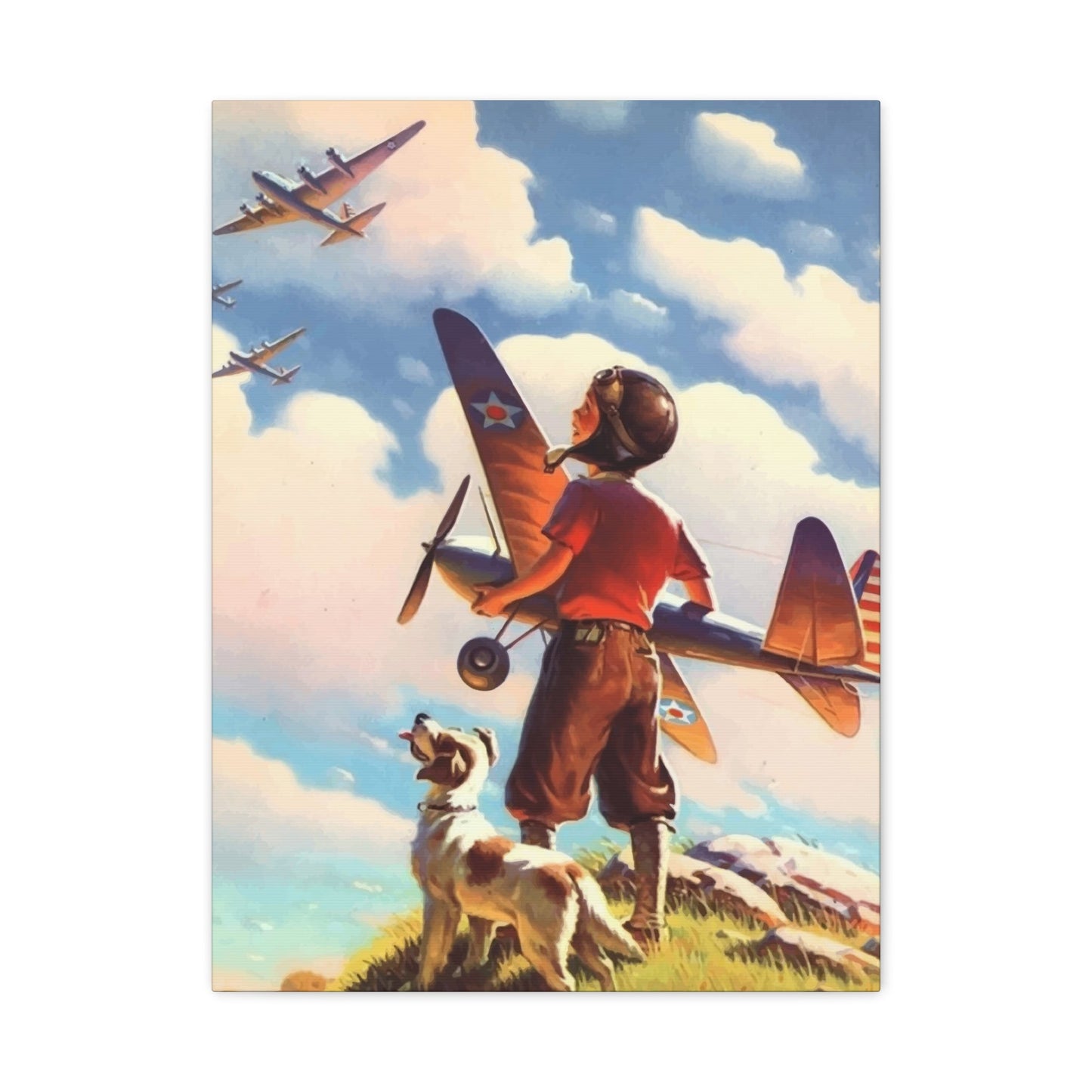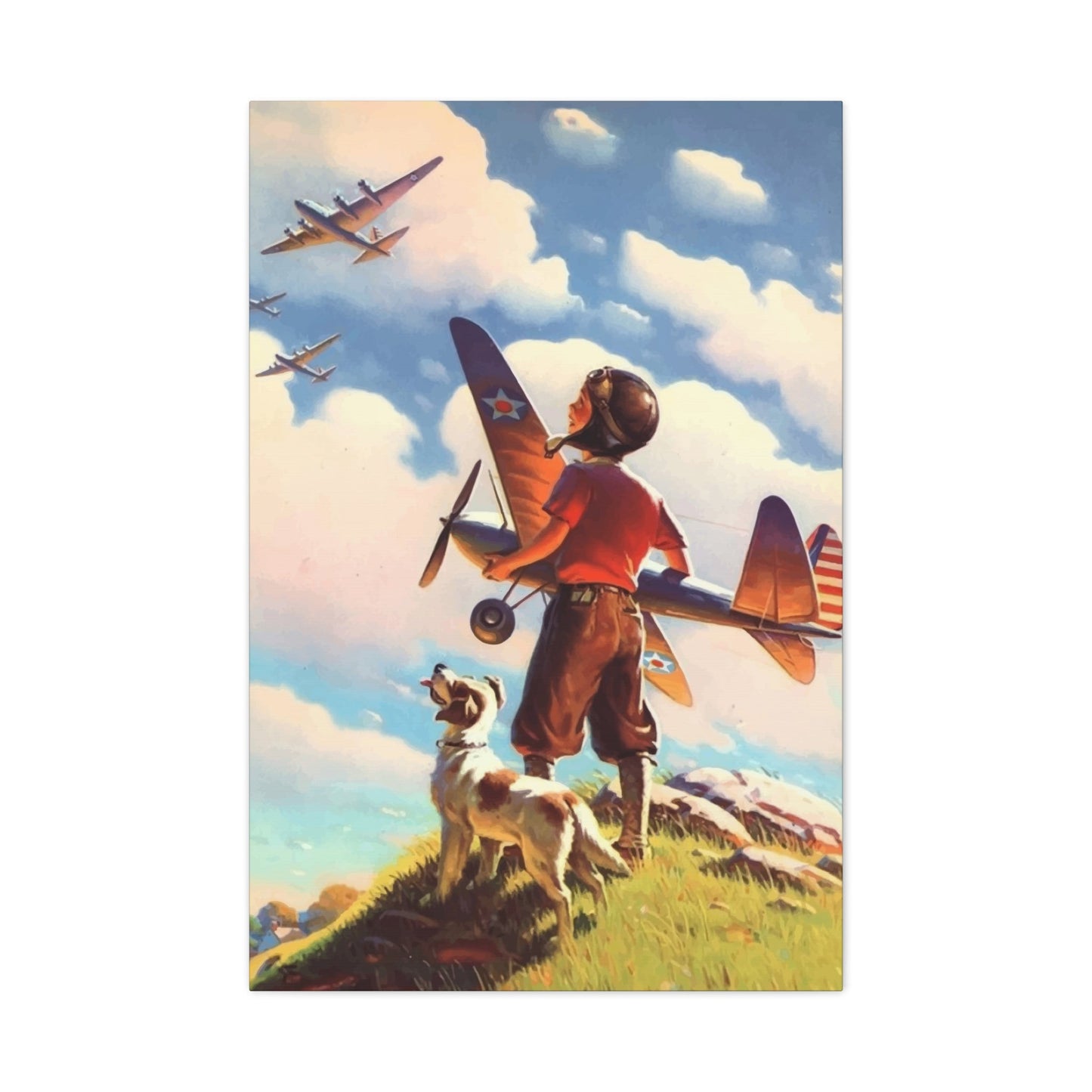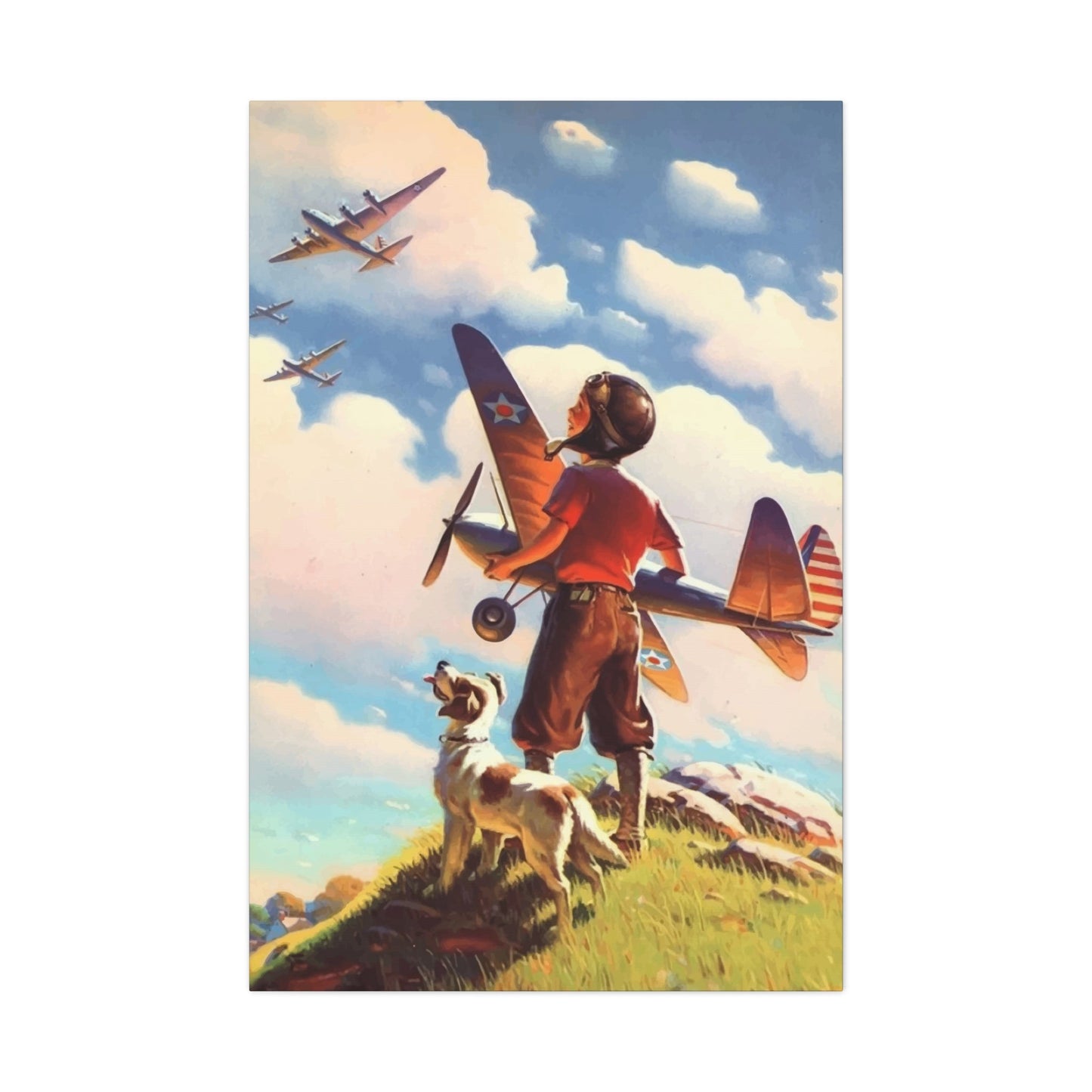Capturing Childhood Wonder: Airplane Wall Art for Young Dreamers
The mesmerizing world of aviation has captivated human imagination for over a century, but nowhere is this fascination more pure and profound than in the eyes of children. When a young child gazes upward at the sky, watching aircraft soar through clouds with effortless grace, something magical happens. Their eyes widen with wonder, their minds race with possibilities, and their hearts fill with dreams of adventure. This enchanting moment between childhood curiosity and the marvel of flight creates the perfect inspiration for transforming any child's environment into a haven of imagination through carefully curated aviation-themed decorative elements.
The relationship between children and aircraft represents one of humanity's most enduring connections to progress, exploration, and the boundless possibilities that await beyond the horizon. From the moment the Wright brothers achieved powered flight in 1903, airplanes have symbolized mankind's ability to transcend limitations and reach for the stars. For children, these magnificent machines represent something even more profound – they embody the very essence of dreams taking flight, literally and metaphorically.
In today's world, where technology often dominates childhood experiences, the timeless appeal of aviation offers parents and educators a unique opportunity to blend education with imagination. Through thoughtfully designed visual elements that celebrate the wonder of flight, we can create environments that not only captivate young minds but also inspire learning, creativity, and a lifelong appreciation for the marvels of engineering and human achievement.
The psychological impact of aviation imagery on developing minds extends far beyond simple decoration. Research in child development consistently demonstrates that visual stimuli in a child's environment significantly influence their cognitive development, emotional well-being, and creative potential. When children are surrounded by images that celebrate human achievement and possibility, they internalize these messages, incorporating them into their developing sense of what they might accomplish in their own lives.
Aviation-themed visual elements serve multiple developmental purposes simultaneously. They introduce children to concepts of physics, engineering, geography, and history while simultaneously nurturing their sense of wonder and possibility. The sleek lines of a jet fighter, the graceful curves of a passenger airliner, or the vintage charm of a biplane each tell stories of human ingenuity and determination that resonate deeply with young minds naturally inclined toward exploration and discovery.
Moreover, the universal appeal of flight transcends cultural boundaries, making aviation-themed environments accessible and inspiring to children from all backgrounds. Whether a child grows up in a bustling metropolis near a major airport or in a rural community where aircraft are occasional visitors to the sky, the dream of flight speaks to something fundamental in the human experience – the desire to explore, to rise above limitations, and to see the world from new perspectives.
The Psychology Behind Children's Fascination With Aircraft
Understanding why children are drawn to airplanes requires delving into the fundamental aspects of child development and the innate human fascination with flight. From an evolutionary perspective, humans have long envied birds' ability to soar through the sky, and this ancient desire manifests powerfully in childhood imagination. When children observe aircraft, they witness the realization of humanity's oldest dream – the conquest of gravity and the freedom of the skies.
Developmental psychologists note that children's attraction to airplanes often emerges during the toddler years, coinciding with their growing awareness of movement and cause-and-effect relationships. The sight of a massive machine defying gravity captures their developing understanding of physics in a way that seems almost magical. This combination of scientific wonder and apparent impossibility creates a perfect storm of fascination that can last well into adulthood.
The sensory aspects of aircraft also contribute significantly to their appeal among young observers. The distinctive sound of jet engines, the visual spectacle of takeoffs and landings, and the sheer scale of commercial aircraft create multisensory experiences that engage children on multiple levels. These encounters often become formative memories, associated with feelings of excitement, wonder, and possibility that can influence career choices and life perspectives decades later.
Furthermore, airplanes represent mobility and adventure in ways that resonate deeply with children's natural desire for exploration. Unlike cars or trains, which travel along predetermined paths, aircraft have the apparent freedom to go anywhere, to rise above obstacles, and to reach destinations that seem impossibly distant. This perceived freedom aligns perfectly with children's imaginative play patterns and their natural inclination to dream beyond immediate circumstances.
The social aspects of aviation also contribute to its appeal among children. Airports are places of reunion and departure, charged with emotion and anticipation. Children quickly learn to associate aircraft with significant life events – family vacations, visits from distant relatives, and other memorable occasions. These positive associations become deeply embedded in their emotional landscape, creating lasting connections between aviation imagery and feelings of excitement and anticipation.
Research in educational psychology suggests that children who develop early interests in aviation often demonstrate enhanced spatial reasoning skills, improved understanding of mathematical concepts, and greater appreciation for scientific inquiry. The complex three-dimensional movement patterns of aircraft naturally exercise visual-spatial processing capabilities, while the technical aspects of flight introduce fundamental concepts in physics, engineering, and meteorology in highly engaging ways.
The role of aviation in popular culture further amplifies its appeal to children. From classic films featuring daring pilots to animated movies about talking planes, popular media consistently portrays aviation as exciting, heroic, and aspirational. These cultural messages reinforce children's natural fascination while providing additional context for understanding the significance of flight in human achievement and exploration.
Historical Context of Aviation Wonder in Childhood
The relationship between children and aviation has evolved dramatically since the early days of powered flight, reflecting broader changes in technology, society, and childhood experiences. In the early 20th century, when aircraft were rare and often dangerous contraptions, children who witnessed flights experienced something truly extraordinary. These early aviation pioneers were viewed as modern-day heroes, and their machines represented the cutting edge of human achievement.
During the 1920s and 1930s, as commercial aviation began to develop, children's exposure to aircraft increased significantly. Air shows became popular family entertainment, and pilots like Charles Lindbergh and Amelia Earhart captured public imagination in ways that deeply influenced young minds. The romance of early aviation, with its emphasis on individual courage and pioneering spirit, created powerful role models for children coming of age during this transformative period.
The Second World War marked a pivotal moment in the relationship between children and aviation. Military aircraft became symbols of national pride and technological superiority, while pilots were celebrated as heroes defending freedom and democracy. Children growing up during this era developed profound connections to aviation that went beyond mere fascination – aircraft represented hope, protection, and the possibility of victory over seemingly insurmountable odds.
The post-war boom in commercial aviation democratized flight in unprecedented ways. For the first time in human history, ordinary families could contemplate air travel as a realistic possibility rather than an impossible luxury. Children born in the 1950s and 1960s grew up during the golden age of aviation, when jet aircraft promised to make the world smaller and more accessible. This generational experience created lasting associations between aviation and progress, opportunity, and global connectivity.
The space race of the 1960s further elevated aviation in children's imagination by extending the concept of flight beyond Earth's atmosphere. Suddenly, aircraft were not just machines for traveling between cities – they were stepping stones to the moon and beyond. Children who watched the Apollo missions understood intuitively that the same principles enabling airplane flight could ultimately carry humans to other worlds.
The advent of wide-body commercial aircraft in the 1970s created new opportunities for children to experience aviation firsthand. These larger, more comfortable aircraft made family air travel more accessible and enjoyable, exposing millions of children to the wonder of flight through personal experience rather than merely observation. The democratization of air travel meant that aviation wonder was no longer limited to children lucky enough to live near airports or air shows.
The development of military aviation technology during the Cold War introduced children to increasingly sophisticated aircraft with capabilities that seemed to blur the line between science and science fiction. Supersonic fighters, stealth aircraft, and precision attack planes captured young imaginations while demonstrating the ongoing evolution of aerospace technology. These advanced aircraft represented the cutting edge of human technological achievement, inspiring children to pursue careers in science, technology, engineering, and mathematics.
The emergence of civilian aerobatic teams and air shows designed specifically for family entertainment created new opportunities for children to experience aviation wonder in safe, accessible environments. These events combined the excitement of high-performance flight with educational elements that helped children understand the principles of aerodynamics, navigation, and aircraft systems.
Developmental Benefits of Aviation Fascination
The educational and developmental advantages that emerge from children's natural fascination with aviation extend far beyond simple entertainment value. When children engage deeply with aviation concepts, they exercise cognitive capabilities that prove beneficial across multiple academic disciplines and life skills. The three-dimensional nature of flight challenges young minds to think spatially about movement, direction, and relative position in ways that enhance mathematical reasoning and geometric understanding.
Children who develop strong interests in aviation typically demonstrate improved performance in science, technology, engineering, and mathematics subjects throughout their academic careers. The complex systems required for safe flight introduce concepts of physics, chemistry, materials science, and environmental science in highly engaging contexts that make abstract principles concrete and understandable. Unlike textbook learning, aviation-based education connects theoretical knowledge to observable phenomena that children can witness personally.
The interdisciplinary nature of aviation education provides unique opportunities for integrated learning experiences. A single aircraft incorporates elements of aerodynamics, propulsion, navigation, communication, weather science, geography, and human factors engineering. Children exploring these connections develop appreciation for how different fields of knowledge work together to solve complex problems, fostering holistic thinking patterns that serve them well throughout their lives.
Language development also benefits significantly from aviation interest. The specialized vocabulary of flight introduces children to precise technical terminology while expanding their general vocabulary through exposure to concepts of measurement, direction, and description. Aviation enthusiasts often develop superior communication skills as they learn to describe three-dimensional movement patterns and complex technical processes clearly and accurately.
Social and emotional development receives substantial benefits from aviation fascination as well. Children interested in flight often participate in organized activities such as model airplane clubs, aviation camps, and air show visits that provide opportunities for peer interaction around shared interests. These experiences build confidence, communication skills, and the ability to work collaboratively on technical projects requiring precision and attention to detail.
The goal-oriented nature of aviation activities teaches children valuable lessons about planning, persistence, and achievement. Building and flying model aircraft requires patience, attention to detail, and the willingness to learn from failure – qualities that translate directly to academic success and personal development. Children learn that complex objectives can be achieved through careful preparation, systematic effort, and continuous improvement.
Aviation interest also promotes environmental awareness and global consciousness. Children fascinated by flight naturally become interested in weather patterns, geographical features, and the interconnected nature of global transportation systems. This broader perspective encourages appreciation for environmental stewardship and international cooperation while developing understanding of how individual actions can have far-reaching consequences.
The problem-solving aspects of aviation education provide excellent preparation for future academic and professional challenges. Aircraft design involves optimization trade-offs between competing objectives such as speed, fuel efficiency, passenger comfort, and safety. Children exposed to these concepts develop analytical thinking skills and learn to evaluate multiple factors simultaneously when making decisions.
Career exploration benefits substantially from early aviation exposure. The aerospace industry encompasses dozens of specialized professions, from pilots and mechanics to engineers, meteorologists, air traffic controllers, and safety specialists. Children who develop aviation interests often discover career paths they might never have considered otherwise, potentially leading to fulfilling professional lives in high-demand technical fields.
Opportunities Through Aviation Imagery
The strategic incorporation of aviation-themed visual elements in children's environments opens numerous pathways for spontaneous learning and structured educational activities. Unlike passive decorative elements, thoughtfully chosen aviation imagery can serve as launching points for exploration across multiple academic disciplines while maintaining the engaging, wonder-filled quality that initially captures children's attention.
Geography education becomes naturally integrated when children's environments feature aircraft from different countries, airports from various continents, or flight routes connecting distant destinations. Parents and educators can use these visual cues to initiate discussions about different cultures, climate zones, time differences, and the logistics of international travel. Children begin to understand the world as an interconnected system where aviation serves as a vital link between distant communities.
Mathematical concepts emerge organically from aviation contexts in ways that make abstract principles concrete and understandable. Aircraft speeds, distances, fuel consumption, passenger capacity, and flight times provide real-world applications for arithmetic, geometry, and basic algebra. Children can explore concepts of scale, proportion, and measurement while working with aviation data that feels relevant and exciting rather than arbitrary.
Science education benefits enormously from aviation imagery that illustrates principles of physics, chemistry, and engineering. The four forces of flight – lift, thrust, drag, and weight – provide concrete examples of how scientific principles operate in the real world. Children can observe and discuss how wing shapes affect airflow, how jet engines convert fuel into forward motion, and how aircraft materials must balance strength, weight, and cost considerations.
Historical education gains depth and relevance when aviation imagery connects children to significant events and personalities from the past. Early aircraft designs illustrate technological progression and human ingenuity, while famous flights and aviators provide entry points for discussing broader historical contexts. Children can explore how aviation developments influenced two world wars, shaped international relations, and accelerated globalization processes.
Environmental science concepts become accessible through aviation imagery that highlights the relationship between human transportation needs and environmental considerations. Children can explore topics such as fuel efficiency, alternative energy sources, noise pollution, and the environmental trade-offs associated with rapid global transportation. These discussions help develop environmental consciousness while maintaining appreciation for technological achievement.
Technology education benefits from aviation imagery that showcases the evolution of aircraft systems, navigation equipment, and communication technologies. Children can trace the development from simple mechanical controls to sophisticated computer-assisted systems, gaining appreciation for how technological advancement occurs through incremental improvement and breakthrough innovation.
Reading comprehension and research skills develop naturally when children become motivated to learn more about aircraft, aviation history, and aerospace technology. Aviation interest often drives children to seek out books, articles, and documentaries that challenge their reading abilities while providing information they genuinely want to acquire. This intrinsic motivation creates ideal conditions for accelerated literacy development.
Creative writing opportunities emerge from aviation themes that inspire children to imagine adventures, create stories about pilots and passengers, or describe the experience of flight from personal or imagined perspectives. The rich sensory aspects of aviation – sounds, sights, and physical sensations – provide excellent material for descriptive writing exercises that help children develop expressive language skills.
Art education connects naturally to aviation through activities involving aircraft design, technical drawing, and creative interpretation of flight themes. Children can explore perspective drawing using aircraft subjects, experiment with color and composition in sky scenes, or create three-dimensional models that integrate artistic expression with technical accuracy.
The Role of Aviation in Fostering Creativity and Imagination
Aviation imagery serves as a powerful catalyst for creative thinking and imaginative play in ways that extend far beyond its immediate visual appeal. The very concept of flight represents humanity's triumph over natural limitations, embodying the kind of breakthrough thinking that characterizes creative problem-solving across all fields of human endeavor. When children engage with aviation themes, they connect with this tradition of innovative thinking while developing their own creative capabilities.
The three-dimensional nature of aircraft movement provides rich material for imaginative play scenarios that exercise spatial reasoning and storytelling abilities simultaneously. Children can envision complex adventures involving multiple aircraft, challenging weather conditions, emergency situations, and heroic rescues that require creative problem-solving and narrative development. These imaginative scenarios help children develop the ability to visualize complex sequences of events while maintaining logical consistency and dramatic tension.
Aircraft design itself represents one of humanity's most elegant solutions to complex engineering challenges, demonstrating how creative thinking can overcome seemingly impossible obstacles. Children exposed to various aircraft configurations begin to understand how different design approaches solve different problems, encouraging them to think creatively about optimization and trade-offs in their own problem-solving efforts.
The historical evolution of aircraft design provides excellent examples of how creative thinking builds upon previous achievements to reach new levels of capability. Children can trace the development from early experimental aircraft through modern commercial aviation, observing how each generation of designers incorporated lessons learned from previous attempts while adding innovative solutions to emerging challenges.
Aviation imagery also stimulates creative thinking about future possibilities and technological development. Children naturally speculate about what aircraft might look like decades from now, how they might be powered, where they might travel, and what new capabilities they might possess. These forward-thinking exercises develop the kind of visionary thinking that drives innovation in all fields of human endeavor.
The international nature of aviation encourages creative thinking about cultural exchange and global cooperation. Children can imagine themselves visiting distant countries, meeting people from different backgrounds, and experiencing diverse environments accessible only through air travel. These imaginative exercises develop cultural awareness and appreciation for diversity while expanding children's conception of their place in the global community.
Creative problem-solving skills develop naturally through aviation-related activities that require children to overcome challenges and obstacles. Building model aircraft, planning imaginary flight routes, or designing airport layouts all involve complex problem-solving processes that encourage creative thinking while providing concrete feedback about the effectiveness of different approaches.
The artistic aspects of aviation provide numerous opportunities for creative expression through drawing, painting, sculpture, and digital media. Aircraft subjects challenge children to represent three-dimensional forms, dynamic movement, and complex mechanical details while encouraging personal interpretation and artistic style development. These creative exercises build confidence in artistic abilities while developing visual observation skills.
Storytelling opportunities abound in aviation contexts that provide rich settings, compelling characters, and dramatic situations for narrative development. Children can create adventures involving pilots, passengers, air traffic controllers, and maintenance crews facing various challenges that require courage, cooperation, and innovative thinking. These storytelling exercises develop language skills while encouraging creative plot development and character creation.
Musical creativity can be inspired by aviation themes through compositions that capture the sounds and rhythms of flight, the excitement of takeoffs and landings, or the peaceful sensation of soaring through clouds. Children can explore how different musical elements can represent various aspects of the aviation experience while developing appreciation for how sound can convey emotion and narrative meaning.
Aviation Wonder on Child Development
The profound psychological effects of aviation fascination on developing minds extend well beyond immediate excitement and interest, creating lasting impacts on personality development, self-concept, and life aspirations. Children who develop strong connections to aviation often demonstrate increased confidence in their ability to understand complex technical systems and solve challenging problems, effects that persist well into adulthood and influence career choices, educational pursuits, and general approach to learning.
The sense of wonder generated by aviation experiences contributes significantly to what psychologists term "cognitive flexibility" – the ability to adapt thinking patterns to new situations and challenges. Children who regularly engage with aviation concepts exercise mental capabilities required to understand three-dimensional movement, complex cause-and-effect relationships, and systematic problem-solving approaches. These cognitive exercises strengthen neural pathways associated with analytical thinking and spatial reasoning.
Aviation fascination often serves as a gateway to broader scientific literacy and technological understanding. Children motivated by aviation interest become more willing to engage with challenging mathematical concepts, physics principles, and engineering problems because these abstract ideas connect directly to phenomena they find inherently fascinating. This intrinsic motivation creates ideal conditions for accelerated learning and deep understanding that extends far beyond aviation-specific knowledge.
The aspirational aspects of aviation imagery contribute to positive identity formation and future goal-setting among children. Aircraft represent human achievement, technological progress, and the possibility of transcending limitations – messages that become internalized as children develop their sense of personal potential. Children surrounded by aviation imagery often develop stronger belief in their ability to achieve ambitious goals and overcome obstacles.
Social development benefits significantly from shared aviation interests that provide common ground for peer interactions and adult mentorship opportunities. Children fascinated by aircraft often seek out others who share their interests, leading to friendships based on mutual curiosity and learning rather than superficial social factors. These relationships often prove more stable and meaningful than casual social connections.
The precision and attention to detail required in aviation contexts help children develop what psychologists call "executive function" – the cognitive skills involved in planning, organizing, and completing complex tasks. Whether building model aircraft, learning about flight procedures, or understanding navigation systems, aviation activities require sustained attention and systematic thinking that strengthen these crucial life skills.
Risk assessment and safety consciousness develop naturally through exposure to aviation safety principles and procedures. Children learn that complex activities require careful planning, adherence to established procedures, and constant vigilance regarding potential hazards. These lessons translate directly to improved decision-making abilities in many other life contexts, from academic projects to physical activities.
The international nature of aviation helps children develop global awareness and appreciation for cultural diversity. Aircraft connect people across continents and cultures, demonstrating how technological cooperation can bridge differences and create opportunities for mutual understanding. Children who grasp these concepts often develop more tolerant and inclusive worldviews.
Emotional regulation skills benefit from aviation activities that require patience, persistence, and the ability to learn from failure. Model aircraft don't always fly successfully on the first attempt, flight simulations involve crashes and mistakes, and understanding complex aviation concepts requires sustained effort over time. Children who persist through these challenges develop resilience and emotional maturity.
The goal-oriented nature of aviation activities teaches children to break complex objectives into manageable steps and maintain motivation over extended periods. Learning to fly a radio-controlled aircraft, for example, requires mastering basic controls before attempting advanced maneuvers. This sequential skill development pattern provides excellent preparation for academic and professional challenges requiring long-term commitment.
Selecting Appropriate Aviation Themes for Different Age Groups
The effectiveness of aviation-themed visual elements depends significantly on matching content appropriately to children's developmental stages and cognitive capabilities. Different age groups respond to different aspects of aviation imagery, and successful environmental design requires understanding these developmental differences while maintaining the inspirational and educational value that makes aviation themes so powerful for childhood development.
For toddlers and preschoolers aged two to four years, aviation imagery should emphasize bright colors, simple shapes, and easily recognizable aircraft forms. Young children respond best to cartoon-style representations that capture the essential characteristics of different aircraft types without overwhelming detail that might confuse or distract from the core concepts. Simple biplanes, colorful hot air balloons, and friendly-looking commercial aircraft work particularly well for this age group.
The sensory aspects of aviation imagery prove especially important for very young children who are still developing their ability to process complex visual information. Bold primary colors, clear geometric shapes, and high contrast between aircraft and background elements help maintain attention while supporting visual development. Images featuring aircraft in motion, with visible propellers or contrails, help convey the dynamic nature of flight in ways that static representations might not achieve.
Safety considerations for this age group require avoiding imagery that might be frightening or overly stimulating. Military aircraft with aggressive styling, complex technical diagrams, or dramatic action scenes may overwhelm young children rather than inspire them. Instead, gentle imagery featuring aircraft in peaceful settings, perhaps with other friendly elements like clouds, birds, or rainbow effects, creates positive associations with aviation themes.
School-age children between five and eight years can handle more detailed and realistic aviation imagery while maintaining their sense of wonder and excitement. This age group benefits from representations that begin to introduce technical accuracy while preserving the magical quality that initially captures their attention. Detailed illustrations of famous aircraft, cutaway views showing internal components, and historical aviation scenes become appropriate and engaging.
The educational potential of aviation imagery expands significantly for this age group, which can begin to understand cause-and-effect relationships and systematic thinking processes. Images that show the four forces of flight, different types of aircraft engines, or the progression of aircraft design through history provide excellent starting points for learning conversations while maintaining visual appeal and age-appropriate complexity.
Geographic and cultural elements become increasingly important for school-age children who are developing awareness of the world beyond their immediate environment. Aviation imagery featuring aircraft from different countries, various airport designs, or flight routes connecting distant destinations helps expand their understanding of global connections while maintaining focus on the aviation elements that capture their interest.
Older children and pre-teens aged nine to twelve can appreciate sophisticated aviation imagery that includes technical details, historical context, and complex engineering concepts. This age group often develops specific interests in particular types of aircraft or aviation activities, requiring more specialized and detailed visual elements that support deeper exploration of chosen topics.
The problem-solving aspects of aviation become particularly relevant for this age group, which is developing abstract thinking capabilities and can understand how different design decisions involve trade-offs between competing objectives. Detailed technical drawings, exploded view diagrams, and comparative analyses of different aircraft designs provide appropriate challenges while maintaining engagement and inspiration.
Career exploration elements become increasingly important as older children begin to consider their future educational and professional paths. Aviation imagery that showcases different aviation careers, from pilots and engineers to air traffic controllers and aerospace researchers, helps broaden their understanding of opportunities available within the aviation industry while maintaining inspirational impact.
Teenagers can benefit from sophisticated aviation imagery that connects to their developing interests in science, technology, and global issues. Advanced aircraft designs, cutting-edge aerospace technology, and the role of aviation in addressing environmental challenges provide appropriate content that respects their cognitive capabilities while maintaining the inspirational quality that makes aviation themes so powerful for personal development.
Themes Through Aviation Imagery
The integration of educational content through aviation-themed visual elements creates opportunities for learning that feel natural and engaging rather than forced or artificial. Unlike traditional educational materials that may seem disconnected from children's interests, aviation imagery provides intrinsically motivating contexts for exploring academic concepts across multiple disciplines while maintaining the wonder and excitement that initially captures attention.
Scientific principles become accessible and understandable when illustrated through aviation contexts that demonstrate abstract concepts through concrete examples. The physics of flight provides excellent opportunities to explore fundamental concepts such as force, motion, energy, and pressure in ways that children can observe and understand. Bernoulli's principle, Newton's laws, and the conservation of energy all find clear expression in aircraft design and operation.
Mathematical concepts gain relevance and meaning when presented in aviation contexts that show how numerical relationships apply to real-world problems. Aircraft performance specifications, flight planning calculations, and navigation procedures all involve mathematical operations that feel important and useful rather than arbitrary academic exercises. Children can explore concepts of ratio, proportion, geometry, and basic algebra through aviation applications.
Engineering principles become understandable through aviation imagery that shows how design decisions affect performance outcomes. The relationship between wing shape and lift generation, the trade-offs between speed and fuel efficiency, and the integration of multiple systems in aircraft design all provide excellent examples of engineering thinking that children can grasp intuitively.
Historical education gains depth and engagement when aviation imagery connects children to significant events and personalities from the past. The Wright brothers' first flight, Lindbergh's transatlantic crossing, the Battle of Britain, and the development of commercial aviation all provide entry points for discussing broader historical themes while maintaining focus on aviation elements that capture children's attention.
Environmental science concepts become relevant and important when presented through aviation contexts that highlight the relationship between human activities and environmental impact. Aircraft fuel consumption, noise pollution, emissions reduction efforts, and sustainable aviation technologies all provide opportunities to discuss environmental stewardship while maintaining appreciation for technological achievement.
Cultural education benefits from aviation imagery that showcases the international nature of modern aviation and the cooperation required for safe global air travel. Different countries' aircraft designs, international airport operations, and the standardization of aviation procedures across cultures all provide examples of how people from diverse backgrounds work together to achieve common objectives.
Technology education finds rich material in aviation imagery that shows how human needs drive technological innovation and how different technologies integrate to create complex systems. The evolution of aircraft engines, navigation equipment, and communication systems all demonstrate how technological development occurs through incremental improvement and breakthrough innovation.
Career exploration becomes natural and engaging when aviation imagery showcases the diverse professional opportunities available within the aerospace industry. From pilots and flight attendants to engineers, mechanics, air traffic controllers, and meteorologists, aviation imagery can introduce children to career possibilities they might not otherwise consider while demonstrating how different skills and interests contribute to complex operations.
Safety education takes on special importance in aviation contexts where the consequences of poor decisions can be severe. Aviation safety procedures, emergency protocols, and the systematic approach to risk management provide excellent examples of how careful planning and attention to detail contribute to successful outcomes in challenging situations.
Global awareness develops naturally through aviation imagery that demonstrates how aircraft connect distant communities and enable cultural exchange. International routes, diverse passenger populations, and the role of aviation in emergency relief and humanitarian efforts all help children understand their place in a connected global community.
Creative Applications of Aviation Themes
The artistic and creative possibilities inherent in aviation themes extend far beyond simple decorative applications, offering rich opportunities for personal expression, skill development, and imaginative exploration that can enhance children's creative abilities while maintaining educational value. Aviation imagery provides compelling subjects for various artistic media while challenging children to represent complex three-dimensional forms, dynamic movement, and technical details.
Drawing and illustration projects benefit enormously from aviation subjects that combine technical precision with artistic interpretation. Children can explore perspective drawing using aircraft subjects, learning to represent three-dimensional forms on two-dimensional surfaces while developing observation skills and hand-eye coordination. The mechanical complexity of aircraft provides excellent practice in drawing geometric forms, parallel lines, and proportional relationships.
Painting projects find rich material in aviation themes that offer opportunities to explore color relationships, atmospheric effects, and compositional principles. Sky scenes with aircraft subjects naturally incorporate color theory lessons about warm and cool colors, complementary relationships, and atmospheric perspective. The contrasts between mechanical aircraft forms and organic cloud formations provide excellent exercises in balancing different visual elements.
Sculpture and three-dimensional projects connect naturally to aviation themes through model-building activities that combine artistic expression with technical accuracy. Children can create aircraft models using various materials while learning about proportion, balance, and structural integrity. These projects help develop spatial reasoning skills while providing tangible results that build confidence and sense of accomplishment.
Digital art and computer graphics find excellent applications in aviation themes that allow children to explore modern artistic tools while creating sophisticated visual compositions. Flight simulation software, 3D modeling programs, and digital painting applications all provide opportunities to create aviation-themed artwork while developing technological skills valuable for future academic and professional pursuits.
Creative writing projects benefit from aviation themes that provide rich settings, compelling characters, and dramatic situations for narrative development. Children can create adventure stories featuring pilots facing challenging weather conditions, science fiction tales about futuristic aircraft, or historical fiction set during significant aviation events. These writing exercises develop language skills while encouraging creative plot development.
Musical composition can draw inspiration from aviation themes through pieces that capture the rhythms and sounds associated with different aspects of flight. The steady drone of propeller engines, the powerful thrust of jet takeoffs, and the peaceful sensation of soaring flight all provide material for musical interpretation while helping children understand how sound can convey emotion and meaning.
Drama and performance activities can incorporate aviation themes through role-playing exercises that help children understand different perspectives and develop communication skills. Children can portray pilots, passengers, air traffic controllers, and ground crew members while learning about cooperation, responsibility, and problem-solving under pressure.
Photography projects can focus on aviation subjects available in local environments, from aircraft flying overhead to airport activities visible from public areas. These projects help children develop visual observation skills while learning about composition, timing, and technical camera operation. The dynamic nature of aviation subjects provides excellent practice in capturing moving subjects.
Craft projects can incorporate aviation themes through activities that develop fine motor skills while creating functional or decorative items. Paper airplane construction teaches basic aerodynamic principles while providing immediate feedback about design effectiveness. More complex craft projects might involve creating detailed dioramas featuring airports, flight scenes, or historical aviation events.
Design projects can challenge children to create their own aircraft concepts, combining artistic vision with technical considerations. These activities encourage innovative thinking while helping children understand how form follows function in engineering design. Computer-aided design software makes it possible for children to create sophisticated aircraft concepts while learning valuable technological skills.
Aviation Safety Education Through Visual Elements
The critical importance of safety in aviation provides excellent opportunities to teach children about risk assessment, careful planning, and systematic approaches to complex activities through engaging visual elements that emphasize these principles without diminishing the excitement and wonder associated with flight. Aviation safety education helps children develop life skills that extend far beyond aviation while building appreciation for the careful attention to detail that makes modern aviation remarkably safe.
Safety procedures and checklists provide excellent examples of how systematic approaches to complex tasks reduce risks and improve outcomes. Aviation imagery that shows pilots conducting pre-flight inspections, air traffic controllers managing multiple aircraft, and maintenance crews performing detailed equipment checks demonstrates how careful attention to established procedures creates safe operating environments.
Emergency preparedness concepts become understandable and important when illustrated through aviation contexts that show how advance planning and proper equipment enable successful responses to unexpected situations. Aircraft safety equipment, emergency evacuation procedures, and rescue operations all provide examples of how preparation and training contribute to positive outcomes during challenging circumstances.
Risk assessment principles find clear expression in aviation contexts where multiple factors must be evaluated simultaneously to make safe decisions. Weather conditions, aircraft performance limitations, pilot experience levels, and airport capabilities all represent variables that must be considered systematically when planning safe flight operations.
The team-based nature of aviation safety provides excellent examples of how individual responsibilities contribute to group success and how effective communication prevents misunderstandings that could lead to problems. Aviation imagery showing coordination between pilots, air traffic controllers, ground crews, and maintenance personnel demonstrates how complex operations require cooperation and clear communication.
Equipment reliability and maintenance principles become understandable through aviation imagery that shows how regular inspection and preventive maintenance keep complex machinery operating safely over extended periods. The systematic approach to aircraft maintenance provides excellent examples of how attention to detail and adherence to established procedures contribute to long-term reliability.
Weather awareness and environmental considerations find clear expression in aviation contexts where atmospheric conditions significantly affect safety and operational effectiveness. Aviation imagery featuring different weather conditions helps children understand how environmental factors affect human activities while building appreciation for meteorology and atmospheric science.
Decision-making under pressure becomes relevant through aviation scenarios that require quick thinking based on systematic training and established procedures. Emergency situations in aviation demonstrate how proper preparation enables effective responses to unexpected challenges while maintaining safety as the primary consideration.
Conclusion
Capturing childhood wonder through airplane wall art is a beautiful way to inspire imagination, curiosity, and dreams in young spaces. Airplanes symbolize adventure, exploration, and limitless possibilities—values that resonate deeply with children as they grow and discover the world around them. Integrating airplane-themed artwork into bedrooms, playrooms, or learning areas encourages young dreamers to think beyond boundaries, fueling creativity and a sense of excitement for life’s journeys.
One of the most appealing aspects of airplane wall art for children is its ability to combine whimsy with educational value. Whether featuring vintage planes, colorful modern jets, or charming illustrations, these artworks spark interest in aviation, geography, and science, offering a subtle yet engaging learning opportunity. The playful designs and vibrant colors capture a child’s attention and help create an environment that is both fun and inspiring.
Airplane wall art also offers great versatility in décor. From minimalist line drawings to detailed, realistic prints or even interactive murals, there is a style suited for every child’s personality and room theme. Such art can be a focal point that ties together other elements of the room, like bedding, toys, and furniture, creating a cohesive and imaginative space. The presence of airplanes in wall art can transform a simple room into a launchpad for creativity and daydreams.
Beyond the visual appeal, airplane art carries a powerful message about freedom and the spirit of adventure. It encourages children to dream big, explore new horizons, and embrace the unknown with courage and curiosity. This emotional connection makes airplane wall art more than just decoration—it becomes a source of inspiration and motivation for young minds.
In conclusion, airplane wall art for young dreamers captures the essence of childhood wonder and adventure in a way that is both beautiful and meaningful. It enriches children's spaces with vibrant energy, creativity, and a sense of possibility that nurtures their growth and imagination. Whether used as a bold statement piece or a subtle accent, airplane-themed artwork invites children to soar in their dreams and inspires a lifelong love of discovery. Incorporating such art into a child’s environment is a thoughtful way to celebrate their potential and encourage a spirit of exploration that will carry them far.













